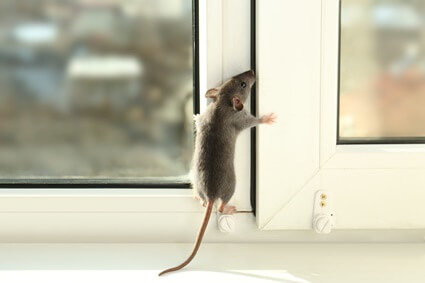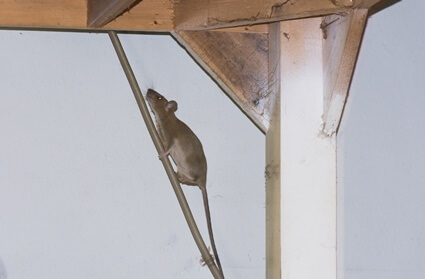Rats are good climbers, capable of scaling walls, fences, trees, brick walls, gutters, and drain pipes.
The roof rat earns its title from its impressive scaling ability. It’ll use trees, nearby objects, or the texture of an exterior wall to gain a vantage point.
Rats can’t climb smooth surfaces like glass, tile, concrete, and polished metal. Any surface that lacks texture or footholds is impossible for a rat to scale.
Rats use padded feet and claws to grip tiny fissures and pockets to ascend vertical surfaces. Unless there are adornments or cracks the rats can leverage, they’ll be stuck on the ground.
Rats can climb up walls with shelves, decorations, and rough textures. They can climb stone, brick, wood, plastic, and gypsum.
If you want to keep rats out, limit access to these surfaces.
What Materials Can Rats Not Climb?
As stated, rats are unable to climb smooth vertical surfaces.
Despite being skilled climbers, rats still need something for their tiny paws to hang on to. Unlike geckos and some insects, they don’t have the little hook hairs on their feet for scaling flat surfaces.
Likewise, rats can’t attach to glass with adhesive or suction. They’re merely skilled at finding handholds and balancing their weight to scale surfaces. When a smooth surface removes these advantages, and there are no adornments, rats can’t climb.
Rats are unable to scale slick surfaces, such as:
- Tiles.
- Polished metal.
- Glass.
- Concrete.
These surfaces are impossible to climb as there will be nothing for rats to latch onto. Similarly, rats will have difficulty climbing concrete walls since the finishes are usually smooth.
However, if the finish has artistic features, rats can easily scale them. Engravings and patterns will provide footholds that rats can use to their advantage.
Are Rats Good Climbers?
Rats are capable climbers and can scale most types of material, especially if the material has a rough texture, which gives them the stability to dig in with their feet.
Rats like climbing surfaces made out of the following substances:
- Stone.
- Brick.
- Wood.
- Plastic.
- Gypsum.
The texture makes it easy for a rat’s paws to grasp and cling onto.
Rats have certain bodily advantages that make them exceptional climbers:
- The claws and pads on their feet make it easy to latch onto surfaces.
- They have sharp claws at the tip of the 5 phalanges (fingers) on each paw, which allows them to tightly grip surfaces.
- Their tails provide balance and stability by wrapping around cords, wires, and ropes as they climb.
Perhaps the quality that makes rats so good at climbing is their ability to leap. According to the University of California, rats can jump vertically to 36 inches and horizontally to 48 inches.
That allows rats to reach high areas where they can find unlikely handholds. Tables, chairs, boxes, window sills, and countertops will be easy targets for rats.

Do Rats Like To Climb?
Rats mainly climb for necessity but appear to enjoy climbing as much as they technically need to climb. Wild rats climb on surfaces to reach areas to hide from predators and access resources.
Rats will seek out locations they can scale and explore. Some species, such as roof rats, must nest in raised locations. They’ll climb trees to nest at the top or use branches to access rooftops and attics.
Their climbing ability allows rats to run vertically, enabling them to perch where cats, dogs, and other predators cannot chase them.
While climbing is natural for rats, Royal Society Open Science observed that younger rats climb more than older rats. The muscle strength and coordination required for climbing decline with age.
How Do Rats Climb Vertical Surfaces?
Several adaptations enable rats to climb on vertical surfaces easily. As mentioned, their padded feet provide the grip they need to latch onto rough surfaces.
Moreover, their fingers have sharp nails that allow them to hold onto surfaces tightly when climbing vertically, ensuring they don’t fall.
Rats are agile jumpers. When standing on their hind legs, their tails offer enough support to propel them upward when jumping to vertical surfaces.
Trees
Rats can climb trees and often use them to leap onto roofs and enter attics.
Roof rats, in particular, like to nest on raised platforms. They’re more likely to access people’s homes via tree overgrowths.
Other species of rats climb trees to reach fruit but rarely nest there.
Brick Walls
Rats can climb brick walls because these surfaces have a rough texture.
Rats will use their tails to propel them upwards when jumping from the ground to a vertical brick wall.
From here, they’ll use their sharp claws to grab onto the wall as they climb, using the pockets and grooves for handholds.
Gutters
Rats can easily climb gutters and other drainage pipes to get inside homes.
Aside from being good climbers, rats are good swimmers, able to wade through water-filled gutters without drowning.
To prevent rats from entering your home through the gutters, you’ll need to install hardware, cloth, or chicken wire at the base of the downspout.
Drainpipes
Rats can climb up drainpipes and sometimes use them as pathways to enter people’s homes.
Once inside a drainpipe, rats can cause damage by gnawing at the pipes and puncturing holes, causing leaks. Then, they contaminate the water flowing through these pipes with their urine and droppings, creating a health hazard.
To stop rats from climbing up drainpipes, ensure no food particles attract them. Additionally, ensure all openings are fitted with drain valves to keep rats from entering.
Fences
Rats can climb fences since they have a textured surface and design that makes them easily scalable. The best rat deterrent is installing an electric fence.
How High Can Rats Climb?
Rats can spring themselves upward to a distance of up to 36 inches.
They can then leap forward a distance of up to 48 inches. This ability makes it possible for rats to climb trees 5 feet away from your home. From here, they’ll jump onto your walls or roof.
Interestingly, rats can survive a fall of up to 50 feet, attempting to climb again after a fall.
Considering their proficient climbing skills, you must minimize gateways that rats can use to enter your home. Trim any tree branches to ensure they’re 5 feet from your home.
Rats use low-hanging cables to climb into people’s homes. So, ensure all your electrical wires are installed high up off the ground.
Can Rats Climb Walls?
Rats can scale walls, but it depends on the wall’s surface.
A rat can climb vertically up a wall with a rough texture and sufficient grip. Walls made from brick, stone, and wood are rough enough for rats to latch onto, thus making them easy to climb.
Walls made from smooth and slick materials, such as polished glass and tiles, are much more challenging for rats to climb as they don’t offer enough grip.
A rat will slide down when it tries to latch onto these surfaces.
How Do Rats Run Up Walls?
Rats can run up walls with a rough texture, offering a solid grip for the paws. In addition, rats have sharp nails that can latch onto vertical walls without falling.
Can Rats Climb Smooth Walls?
Rats cannot climb smooth walls because these surfaces don’t provide any grip. Also, they have little friction due to the polished surface, so the rat will slide back when it attempts to climb.

How To Stop Rats Climbing
Rats can enter your home by scaling the following:
- Walls.
- Trees.
- Cables.
- Drainpipes.
Once inside, rats can damage your property and put your family at risk of diseases. So, you must take the necessary steps to prevent rats from climbing.
Here are some ways to keep rats out of your home:
Cut Back Nearby Bushes and Trees
Trees and bushes are favored places for rats, as they provide food and safety and give them access to roofs and windows.
Roof rats will scale if you have tree overgrowths with branches extending over your roof. From here, they’ll leap onto your roof and get into your attic as they can squeeze through tight spaces.
To prevent rats from entering your home through tree branches, trim any tree less than 5 feet away. Moreover, cut the grass at the bottom of hedges and bushes to deter nesting.
Seal Drain Pipes with a Rat Blocker
Rats hide in sewers and drainpipes., often using them to enter people’s homes.
Not only can rats climb through drain pipes, but their swimming ability makes it easier to move through them, even with fast-moving water currents.
The best way to keep rats from climbing up your drainpipes is to install a non-return valve with a single flap. The single-flap valve is designed so rats inside the drain pipe can go out but not climb back up.
These are essential as, without them, rats can come up toilets.
Wrap Your Electrical Cables with Rodent Repellent Tape
Electrical cables and wires are some of the easiest objects for rats to climb. After all, they can latch onto them with their paws and tail as they climb.
Aside from using electrical cables to move to different locations, they chew on wiring, causing significant damage to electrical systems.
Wrapping electrical wires and cables with rodent-repellent tapes (often treated with Capsaicin) can deter rats from scaling them.
Install Wall Guards to Prevent Rats from Climbing
Installing wall guards around the base of exterior walls discourages rats from climbing them. Ideally, the wall guard should be composed of metal plates with a smooth texture.
This will prevent rats from latching onto them with their feet or chewing through them. They should be at least 12 inches wide and 36 inches above the ground to prevent rats from jumping on them.
Rats are great climbers, but they cannot climb entirely smooth surfaces. You can deny rats access by creating more unscalable surfaces outside the home.







